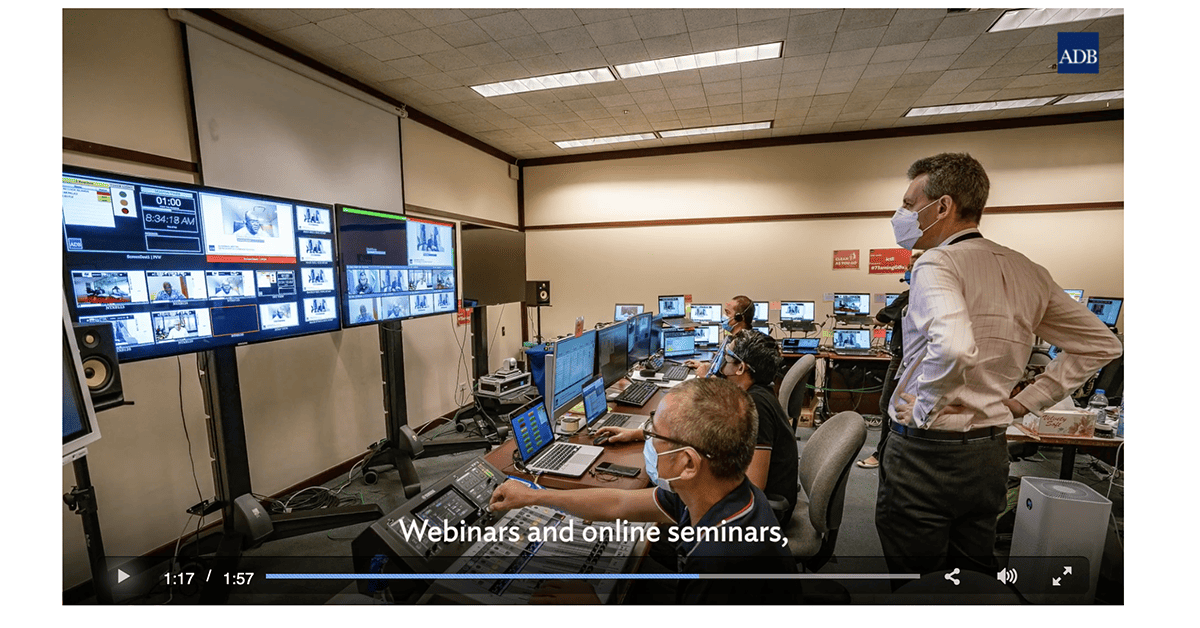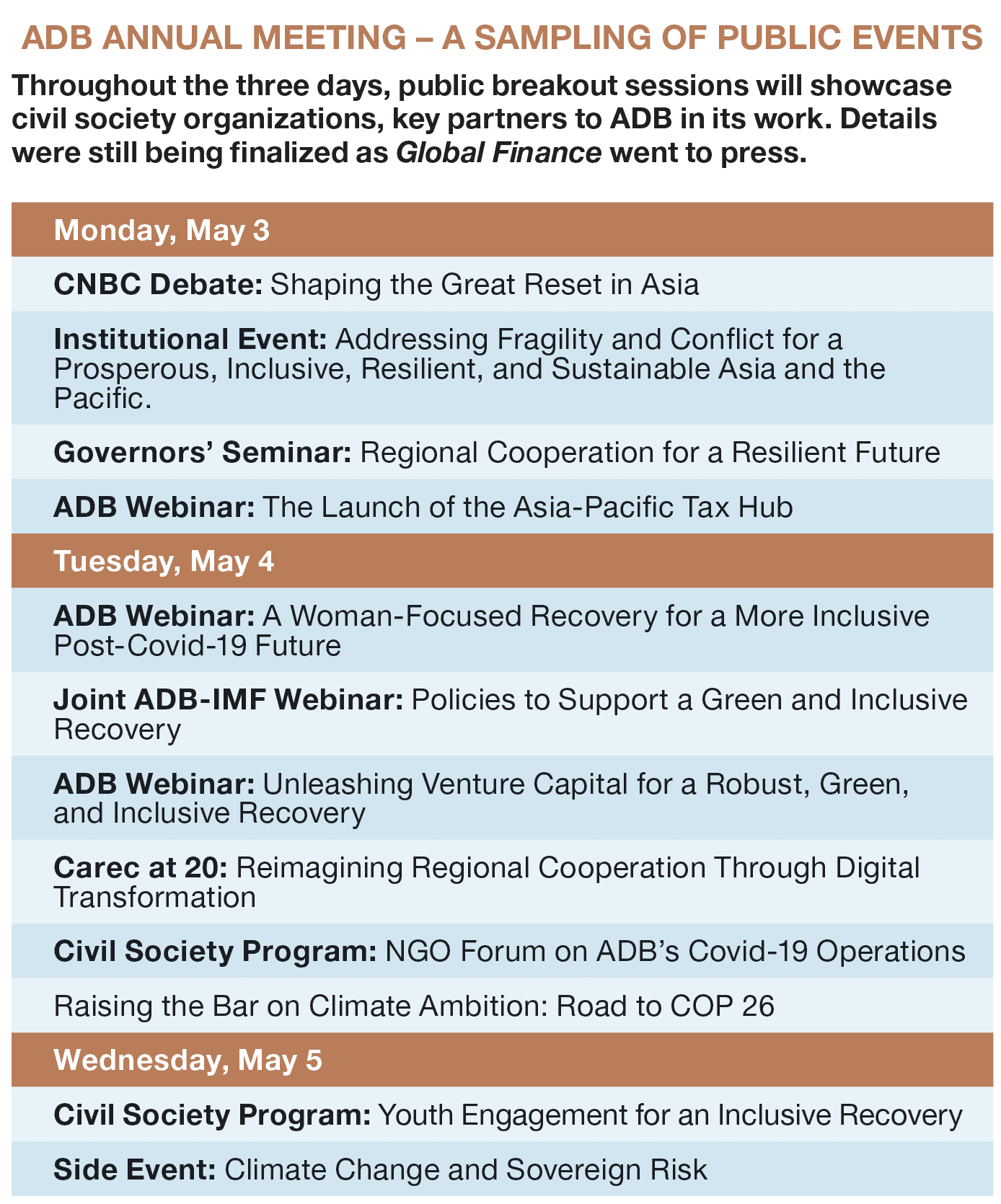The Asian Development Bank is holding its annual meeting remotely this month—for just the second time in its history. Covid-19 recovery and sustainability will be key topics.

Recovery from the Covid-19 pandemic and the accompanying economic collapse is the “immediate challenge” facing developing Asia, says Tomoyuki Kimura, director general of the Asian Development Bank’s (ADB’s) Strategy, Policy and Partnerships department. But the region’s governments and economies must “balance the pandemic response, including vaccine support, and medium to long-term investments, to promote a green, resilient and inclusive recovery,” he adds.
The ADB’s 54th annual meeting, May 3-5, will bring together a broad range of stakeholders to address this balancing act, including ADB officials, representatives from government and private enterprise, nongovernmental organizations, development experts and partners and economists. As the central theme of the meeting—“Collaboration for Resilient and Green Recovery”—indicates, it will focus on economic recovery in Asia and the Pacific, climate change, the “greening” of economies in the region and how to boost the role of the private sector in development.
Discussions will focus partly on “relaunching Asia and the Pacific economies after the pandemic, compared to last year when the situation was new, and topics focused on dealing with the health and economic crisis in the region,” says ADB Secretary Muhammad Ehsan Khan.
Intraregional collaboration is also a key theme: a major achievement of the ADB in the past year has been to create a regional hub on domestic resource mobilization and international tax cooperation, which will be showcased at this year’s meeting. Efficient and well-administered tax and domestic resource mobilization systems “enable higher quality governance,” says Kimura, “enhance fiscal and debt sustainability and create an environment for the private sector to flourish and for countries to maintain a sustainable post-pandemic recovery.”
Tax efficiency in turn feeds into one of the ADB’s overarching objectives. As part of its Strategy 2030 road map, the bank aims to promote social and economic development in the region, helping the region to achieve a more prosperous, inclusive and sustainable future.. Areas of emphasis include supporting better access to reliable power, safe drinking water, high-quality education and health care services and effective social-protection systems. The bank also is looking to focus on climate adaptation and reducing the impact of climate change, which means incorporating climate and disaster resilience in its offering, particularly in the context of Covid-19 recovery.
Balancing Development and Recovery
Bank officials hasten to emphasize that Asia Pacific is still a developing region, despite the notable success that many countries have achieved. Much of the narrative about the so-called Pacific Century focuses on the powerhouses of economic growth. Vietnam—widely exhibited as a development success and a prime beneficiary, as parts of the global supply chain move away from China—enjoyed average GDP growth of 6.5% per year since 2020. GDP in Myanmar, one of the region’s brightest spots until the recent overthrow of the elected government, rose 9.6% per year.
Sometimes overlooked are parts of Asia that are developing far more slowly. According to the ADB, 263 million people in the Asia Pacific live on less than $1.90 a day and 1.1 billion get by on less than $3.20 a day.
The ADB aims to support the countries most in need through lending, technical assistance, grants and equity investment. According to the bank’s most recent annual report, in 2019 these amounted to $21.6 billion, along with cofinancing of $11.9 billion and $16.5 billion disbursed to member states.
Repairing Pandemic Damage
Covid-19 recovery, however, remains the most pressing item on the ADB’s current docket. The bank started delivering funding and assistance to support its developing members in January, of last year well before many countries had recognized the coronavirus as a real and present danger.
Then in April, it put together a $20 billion support package. This helped governments “finance their countercyclical economic stimulus packages, including crisis-related social-protection programs, with emphasis on the poor and vulnerable, especially women and children,” says Kimura. This year, he says, the ADB’s Covid-19 response is expanding through a $9 billion funding facility to help support and “ensure fair and equitable distribution of safe and effective vaccines, including to the poorest and most vulnerable.”
As of mid-March, $425 million to support vaccine procurement by the Philippines had been approved.
The 2021 annual meeting will be held in two parts, both remotely; already last year, the ADB had its first experience with virtual shareholder meetings. “We now have a lot more experience and practice for this year’s meeting,” says Khan. This year’s meeting will expand to include webinars on development in conflict-affected states, on civil society and on venture capital, along with high-level ministerial events with regional governors and other speakers.




